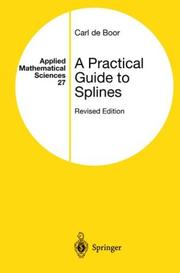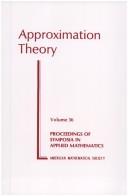| Listing 1 - 10 of 10 |
Sort by
|
Book
ISBN: 0122083504 132255868X 1483268071 9780122083501 Year: 1974 Volume: 33 Publisher: New York (N.Y.): Academic press,
Abstract | Keywords | Export | Availability | Bookmark
 Loading...
Loading...Choose an application
- Reference Manager
- EndNote
- RefWorks (Direct export to RefWorks)
Numerical solutions of differential equations --- Numerical approximation theory --- Partial differential equations --- Differential equations, Partial --- Finite element method --- Congresses --- -Finite element method --- -519.6 --- 681.3 *G18 --- FEA (Numerical analysis) --- FEM (Numerical analysis) --- Finite element analysis --- Numerical analysis --- Isogeometric analysis --- Computational mathematics. Numerical analysis. Computer programming --- Partial differential equations: difference methods; elliptic equations; finite element methods; hyperbolic equations; method of lines; parabolic equations (Numerical analysis) --- Congresses. --- 681.3 *G18 Partial differential equations: difference methods; elliptic equations; finite element methods; hyperbolic equations; method of lines; parabolic equations (Numerical analysis) --- 519.6 Computational mathematics. Numerical analysis. Computer programming --- 519.6 --- Éléments finis, Méthode des --- Éléments finis, Méthode des. --- Finite element method. --- Differential equations, Partial - Congresses --- Finite element method - Congresses --- Equations aux derivees partielles --- Elements finis
Book
ISBN: 9780387953663 0387953663 Year: 2001 Volume: 27 Publisher: New York (N.Y.): Springer,
Abstract | Keywords | Export | Availability | Bookmark
 Loading...
Loading...Choose an application
- Reference Manager
- EndNote
- RefWorks (Direct export to RefWorks)
Spline theory --- Splines, Théorie des --- Spline theory. --- 519.65 --- AA / International- internationaal --- 303.0 --- 511.422 --- Spline functions --- Approximation theory --- Interpolation --- Approximation. Interpolation --- Statistische technieken in econometrie. Wiskundige statistiek (algemene werken en handboeken). --- 519.65 Approximation. Interpolation --- Splines, Théorie des --- Statistische technieken in econometrie. Wiskundige statistiek (algemene werken en handboeken)

ISBN: 0387903569 3540903569 9780387903569 Year: 1978 Volume: 27 Publisher: New York: Springer,
Abstract | Keywords | Export | Availability | Bookmark
 Loading...
Loading...Choose an application
- Reference Manager
- EndNote
- RefWorks (Direct export to RefWorks)
Spline theory --- Splines, Théorie des --- 518.1 --- Spline functions --- Interpolation --- Numerieke benaderingsleer --- Spline theory. --- Splines, Théorie des --- #TWER:BOEK --- 519.65 --- Approximation theory --- 519.65 Approximation. Interpolation --- Approximation. Interpolation --- Numerical approximation theory --- computer applications --- Splines. --- Approximation et developpements --- Splines --- Analyse mathematique

ISBN: 0387941010 3540941010 9780387941011 Year: 1993 Volume: 98 Publisher: New York (N.Y.): Springer,
Abstract | Keywords | Export | Availability | Bookmark
 Loading...
Loading...Choose an application
- Reference Manager
- EndNote
- RefWorks (Direct export to RefWorks)
This book on box splines is the first book giving a complete development for any kind of multivariate spline. Box splines give rise to an intriguing and beautiful mathematical theory that is much richer and more intricate than the univariate case because of the complexity of smoothly joining polynomial pieces on polyhedral cells. The purpose of this book is to provide the basic facts about box splines in a cohesive way with simple, complete proofs, many illustrations, and with an up-to-date bibliography. It is not the book's intention to be encyclopedic about the subject, but rather to provide the fundamental knowledge necessary to familiarize graduate students and researchers in analysis, numerical analysis, and engineering with a subject that surely will have as many widespread applications as its univariate predecessor. This book will be used as a supplementary text for graduate courses. The book begins with chapters on box splines defined, linear algebra of box spline spaces, and quasi-interpolants and approximation power. It continues with cardinal interpolation and difference equations, approximation by cardinal splines and wavelets. The book concludes with discrete box splines and linear diophantine equations, and subdivision algorithms.
Spline theory. --- Spline theory --- 517.518.8 --- 519.6 --- 681.3*G12 --- Spline functions --- Approximation theory --- Interpolation --- Approximation of functions by polynomials and their generalizations --- Computational mathematics. Numerical analysis. Computer programming --- Approximation: chebyshev; elementary function; least squares; linear approximation; minimax approximation and algorithms; nonlinear and rational approximation; spline and piecewise polynomial approximation (Numerical analysis) --- 681.3*G12 Approximation: chebyshev; elementary function; least squares; linear approximation; minimax approximation and algorithms; nonlinear and rational approximation; spline and piecewise polynomial approximation (Numerical analysis) --- 519.6 Computational mathematics. Numerical analysis. Computer programming --- 517.518.8 Approximation of functions by polynomials and their generalizations
Book
Abstract | Keywords | Export | Availability | Bookmark
 Loading...
Loading...Choose an application
- Reference Manager
- EndNote
- RefWorks (Direct export to RefWorks)
Book
ISBN: 0122083601 9780122083600 Year: 1978 Volume: 41 Publisher: New York (N.Y.) : Academic press,
Abstract | Keywords | Export | Availability | Bookmark
 Loading...
Loading...Choose an application
- Reference Manager
- EndNote
- RefWorks (Direct export to RefWorks)
Numerical analysis --- Congresses --- -519.6 --- 681.3*G1 --- Mathematical analysis --- Computational mathematics. Numerical analysis. Computer programming --- Congresses. --- 681.3*G1 Numerical analysis --- 519.6 Computational mathematics. Numerical analysis. Computer programming --- 519.6 --- Numerical analysis - Congresses

ISBN: 0821800981 Year: 1986 Volume: vol 36 Publisher: Providence (R.I.) : American mathematical society,
Abstract | Keywords | Export | Availability | Bookmark
 Loading...
Loading...Choose an application
- Reference Manager
- EndNote
- RefWorks (Direct export to RefWorks)
Approximation theory --- -517.518.8 --- 519.6 --- 681.3*G12 --- Theory of approximation --- Functional analysis --- Functions --- Polynomials --- Chebyshev systems --- Congresses --- Approximation of functions by polynomials and their generalizations --- Computational mathematics. Numerical analysis. Computer programming --- Approximation: chebyshev; elementary function; least squares; linear approximation; minimax approximation and algorithms; nonlinear and rational approximation; spline and piecewise polynomial approximation (Numerical analysis) --- Congresses. --- 681.3*G12 Approximation: chebyshev; elementary function; least squares; linear approximation; minimax approximation and algorithms; nonlinear and rational approximation; spline and piecewise polynomial approximation (Numerical analysis) --- 519.6 Computational mathematics. Numerical analysis. Computer programming --- 517.518.8 Approximation of functions by polynomials and their generalizations --- 517.518.8 --- Approximation. (Congrès) --- Benadering. (Congres)
Book
ISBN: 9781614515982 1614515980 1614515050 1614519595 1614515042 9781614515043 9781614515050 Year: 2015 Volume: 53 Publisher: Berlin, [Germany] ; Boston, [Massachusetts] : De Gruyter,
Abstract | Keywords | Export | Availability | Bookmark
 Loading...
Loading...Choose an application
- Reference Manager
- EndNote
- RefWorks (Direct export to RefWorks)
Taking up where the the chronicle of the monk Theophanes leaves off , the compilation known as Theophanes Continuatus was originally commissioned by the emperor Constantine VII (912-959) and marked the revival, or reinvention, of the genre of history in Byzantium, which also included the less successful text of Genesios, who worked with the same dossier of sources. A principal source for the second period of Iconoclasm and the Amorian dynasty, the tendentious narrative of Books I-IV of Theophanes Continuatus was intended to justify the murderous accession of Basil I (867-886), grandfather of Constantine VII and founder of the Macedonian dynasty, by presenting the emperors who preceded Basil as cruel heretics (Leo V, Michael II, Theophilus) or profligates (Michael III). But the facts here recorded and the often playful use of Classical learning give proof to the careful reader that the revival of Byzantine military power and culture from the Dark Age of the seventh and eighth centuries gained momentum under these same emperors. The present critical edition of Books I-IV replaces that of 1838 by I. Bekker. Accompanied by the first complete English translation and grammatical and historical indexes, the work is intended for specialists, students, and scholars in related fields.
Emperors --- Empereurs --- Biography. --- Biographies --- Basil --- Byzantine Empire --- Empire byzantin --- History --- Biographie --- Histoire --- Basile --- Historiographie. --- Basil I, --- Byzantium (Empire) --- Vizantii︠a︡ --- Bajo Imperio --- Bizancjum --- Byzantinē Autokratoria --- Vyzantinon Kratos --- Vyzantinē Autokratoria --- Impero bizantino --- Bizantia --- Emperors - Byzantine Empire - Biography --- Basil - I, - Emperor of the East, - approximately 812-886 --- Byzantine Empire - Biography --- Byzantine Empire - History - 527-1081

ISBN: 3519018578 9783519018575 Year: 1972 Publisher: Stuttgart: Teubner,
Abstract | Keywords | Export | Availability | Bookmark
 Loading...
Loading...Choose an application
- Reference Manager
- EndNote
- RefWorks (Direct export to RefWorks)
Book
ISBN: 3519013932 3519013924 9783519013921 9783519013938 Year: 1978 Publisher: Stuttgart: Teubner,
Abstract | Keywords | Export | Availability | Bookmark
 Loading...
Loading...Choose an application
- Reference Manager
- EndNote
- RefWorks (Direct export to RefWorks)
| Listing 1 - 10 of 10 |
Sort by
|

 Search
Search Feedback
Feedback About UniCat
About UniCat  Help
Help News
News